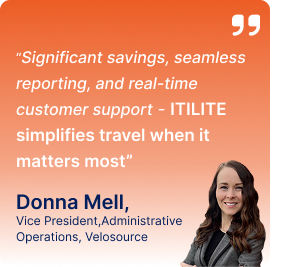
If you send your employees for business travel frequently, it is necessary to ensure their safety while on the road. To achieve this, you must implement plans that lower the impact of risks. Some events that pose a risk to business travelers include terrorism, crime, health-related risks, and natural disasters.
Corporate travel risk management requires a structured framework that ensures the organization’s duty of care toward its employees. It helps both the risk management team and employees to stay prepared in case of an emergency.
Below is step-by-step guidance on implementing a corporate travel risk management program.
Steps to Implement a Successful Corporate Travel Risk Management Program
Stage 1: Prevent
Conduct Travel Risk Assessment
The first step to building an effective business travel risk management program is to identify the corporate travel risks that an employee might face. These include:
- Destination-related risks – Crimes, political instability, natural disasters, etc.,
- Individual risks – Risks due to health conditions, gender, traveling patterns (e.g., too many overnight flights), etc.
Travel risk assessment is crucial in mitigating it where possible. In addition, it helps companies determine whether the employee should take the trip.
Get Free Traveler Risk Assessment Checklist
Analyze Travel Data
If your employees have taken business trips in the past, you can analyze the trip data. It can help you manage risks in multiple ways. Travel data analysis enables you to identify past trends to predict risks in the future. Further, you can check the number of trips that do not comply with the corporate travel security policy.
In addition, to ensure that the traveler doesn’t face extreme health risks, you can analyze several factors, such as the number of red-eye flights, the number of time zones crossed during the journey, and the overall length of the trip.
Free Travel Security Policy Template
Develop Risk Management Strategies
Once you’ve assessed the risks, you must draft strategies to minimize them. The plan that you implement during an emergency depends mostly on the location of the employee, the level of risk, and the resources available at that time.
However, it is crucial to have a step-by-step framework that companies can use and then make further decisions based on the situation.
Corporate travel risk management strategies include:
- Creating comprehensive travel safety policies for employees to follow
- Establishing emergency communication protocols
- Developing evacuation plans
- Establishing a disaster recovery procedure
- Creating contingency framework
- Incorporation of government advisories to plans
- Equipping the risk management team with the resources required to handle incidents
Communicate Protocols Effectively
After you have created the policies and procedures, it is important to communicate them to employees so that they are aware of the steps to avoid the risks. You can send the policy document via email or company application.
However, to ensure that employees understand all aspects of the policy, you can conduct in-person awareness sessions. Such sessions are helpful in clearing the doubts of employees and preventing misunderstandings regarding protocols.
Train your Employees
Before you let your employees go on a business trip, you must train them to assess and respond to potential safety hazards. Discuss the kind of dangers they may face and conduct decision-making exercises with them so that they can act quickly in case of an emergency.
Travelers must know the steps to follow if they face any dangers, learn to prioritize actions and make decisions after weighing the risks. Role-play or risk simulation is also an effective way of training employees to handle situations.
Such training improves the situational awareness of travelers and enables them to stay as safe as possible during their trip.
Insure your Employees
Business travel insurance is necessary to enhance the safety of your employees and provide coverage for various risks that an employee might face during their business trip. The main areas for coverage include medical, trip cancellation, loss of luggage or other items, and life.
Unforeseen situations such as flight disruptions, theft, and medical emergencies can often end up costing a lot to the traveler. However, travel insurance reduces the financial impact of these risks, giving business travelers an extra layer of security.
Provide SOS Contact Numbers
Your business travelers should have all emergency contact numbers so they can quickly reach out to them when required. Typically, business travelers need to have access to contact details of emergency services, embassies, travel insurance company, local police, credit card providers, and airline customer service.
Stage 2: Monitor
Live-Track Business Travelers
Knowing the whereabouts of your employees is extremely important to ensure their safety. For instance, if an employee meets with an accident, you’ll be able to locate your employee and offer medical assistance as soon as possible. Moreover, live tracking helps you ensure that employees are not going to restricted or unsafe locations.
To live-track business travelers, you can opt for a business travel management software solution that uses GPS to get the exact location of your employee. This way, you can see where your employees are at all times on a single dashboard.
Provide Round-The-Clock Travel Support
To fulfill the duty of care and ensure the well-being of employees, it is essential to provide employees with 24/7 travel support. Employees may often face challenges while traveling, such as being stuck in an unfamiliar location, finding a hotel risky, or encountering other potential threats. In such situations, they should be able to reach out to the travel support team, who can provide the necessary help.
If you do not have in-house resources to provide travel support to your employees around the clock, you must consider outsourcing it. For this purpose, you can partner with a travel management company that has a dedicated travel support team to assist your employees even beyond business hours.
Stage 3: Respond
Assess the Situation
Once you get to know about the threat, you must first ensure that the employee is safe. To do this, you can contact the business traveler directly or get in touch with the local authorities.
You can also use news channels and social media to gain as much information as possible. Next, with the information you have gathered, determine the level of risk the traveler faces.
Implement Crisis Management Plan
Depending on the severity of the risk, you can implement the due course of action to bring the traveler safely back home. This may involve quickly evacuating the traveler to a safer location or implementing additional security measures. Further, you may also have to arrange alternative flights or other means of transport.
It is crucial to maintain regular contact with the traveler and guide them on the steps they must take. In the event of a medical emergency, it is important to locate the traveler and connect them with the nearest health facility for immediate aid.
Review the Incident and Implement Feedback
After any incident, it is essential to conduct a thorough review of what happened, why it happened, and how it was handled. This can help identify areas for improvement and prevent similar incidents from occurring in the future.
Further, to keep your corporate travel risk management program optimized, collect feedback from travelers and other people from the company involved in the incident. Feedback can be gathered through surveys, focus groups, or one-on-one interviews.
Based on the findings from the incident review and feedback gathering, risk management protocols should be improved. This includes updating policies and procedures, providing additional training to staff, and making changes to emergency response plans.
Keep your Travelers Safe with a Comprehensive Corporate Travel Risk Management Program
The safety of business travelers is paramount, and companies must take the necessary steps to ensure it. One component of effective risk management is deploying a corporate travel management software solution.
ITILITE is an advanced travel and expense management software that allows you to live track all your travelers from a single dashboard. We also offer 24/7/365 business traveler support so that they can reach out to us in need of any assistance or emergency. Further, you can block unsafe destinations and avoid worrying about employees making bookings in those areas.
To know more about the safety benefits, book a demo now.
Calculate your savings now!
Frequently Asked Questions(FAQ’s)
A Corporate Travel Risk Management Program is a comprehensive strategy designed to ensure the safety and well-being of employees while they are traveling for business purposes. It includes policies, procedures, and tools to mitigate travel-related risks, such as health emergencies, security threats, and natural disasters.
A Travel Risk Management Program is essential for:
a) Ensuring the safety and security of employees.
b) Reducing legal liabilities related to duty of care obligations.
c) Maintaining business continuity during travel disruptions.
d) Enhancing employee confidence and morale while traveling.
Typically, the responsibility for managing travel risks falls on a combination of departments, including Human Resources, Corporate Security, and the Travel Management team. Larger companies might have a dedicated Travel Risk Manager.








